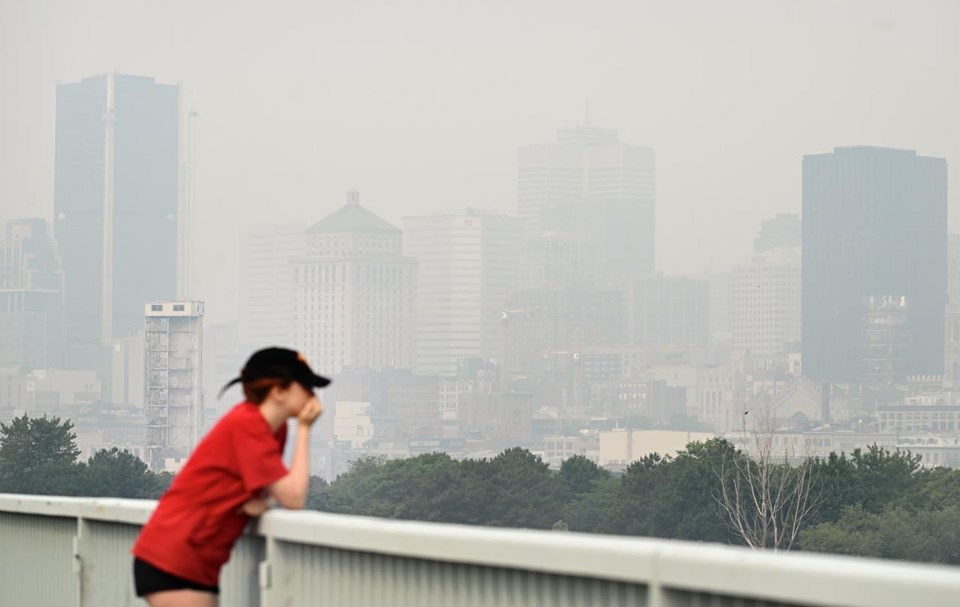MONTREAL — Canada surpassed the record for area burned by wildfires in a single year Monday as hundreds of fires continued to blaze in almost every province and territory.
The Canadian Interagency Forest Fire Centre reported Monday afternoon that 76,129 square kilometres of forest and other land has burned since Jan. 1. That exceeds the previous record set in 1989 of 75,596 square kilometres, according to the National Forestry Database.
Last week federal Emergency Preparedness Minister Bill Blair said he wasn’t "looking to break any records" but acknowledged it was likely coming. "Unfortunately the fire season this year started earlier and has been more widespread across the country than in recent memory," he said.
It took less than six months to surpass the previous record for an entire year. And in 1989, more than 11,000 different fires combined to create the total, with an average size of about seven square kilometres. This year, there have been less than 3,000 fires so far, but they have averaged about 26 square kilometres in size.
Currently there are 490 fires burning nationally, with 255 of them considered to be out of control.
In Quebec, where nearly a quarter of the fires are burning, heavy smoke grounded water bombers in the province's north Monday and caused widespread smog warnings farther south.
Nicolas Vigneault, a spokesman for the province's forest fire prevention agency, said the smoke had reduced visibility, making it impossible for some water bombers and helicopters to take off.
"We do as (many) operations as we can in the field with the firefighters, and in the air with the planes and helicopters," he said. "But our priority is the security of everybody, and the smoke is a challenge right now, and it's been a challenge over the last two or three days."
However, he said heavy rain and some wind is expected in the most affected parts of the province in the coming days, which should allow operations to resume "almost normally."
While no towns are under immediate risk of burning, the fires have forced thousands of Quebecers from their homes. That includes the 2,000 residents of Lebel-sur-Quévillon, parts of Val-d'Or and Senneterre and some Indigenous communities.
In a Monday afternoon update, the fire prevention agency said the fire burning near Lebel-sur-Quévillon remained out of control, and had grown to more than 4,400 square kilometres.
"Again yesterday, the lack of visibility for our aircraft had an impact on fire suppression operations" at the Lebel-sur-Quévillon fire, the agency wrote on its Facebook page. "We did some tests, but no plane or helicopter could complete a mission due to the dense smoke."
It said "significant" rain was expected in the northwest of the province beginning late Monday or Tuesday, but strong winds ahead of the wet weather could make fire conditions challenging.
The Cree Nation of Mistissini announced late Sunday that it was asking all remaining community members to evacuate the area due to a fire threatening nearby Highway 167.
"The dryness index is 100, the highest that can be recorded, and the intensity of the fire is really high," read one of a series of posts on the community's Facebook page.
Authorities noted that the forest fire agency was unable to get images of the fire due to low visibility, which made it hard to track its progress. A plan was in the works to protect the community by widening firebreaks, bringing in water tankers to combat spot fires and putting sprinklers at the entrance to the community.
Meanwhile, heavy smoke forced the Cree community of Waswanipi to announce plans to evacuate another 50 residents, including seniors, pregnant women and infants under one year old.
In a video update late Sunday, Chief Irene Neeposh asked residents who remained in the community to keep their children inside, keep their doors and windows closed and wear a proper-fitting mask while outside.
"We are strongly, I repeat strongly, advising that you do not let your children play outside," she said. "The smoke being this dense is extremely toxic."
There was better news in three small communities near the Ontario border, where officials said the more than 300 residents of Val-Paradis, Beaucanton and Lac Pajegasque could go home after being forced to leave on Friday.
The Atikamekw of Opitciwan, about 600 kilometres north of Montreal, also announced that residents of the area who had been evacuated would be allowed to return on Tuesday.
Environment Canada issued smog warnings for much of the province, including Montreal and Quebec City, due to poor air quality caused by fine particles in the air. The department also issued special weather statements for many of those same cities, forecasting 20 to 40 millimetres of rain in some areas, with more than 50 mm possible in thunderstorms.
By late afternoon, the smog warnings had been lifted for the south of the province between Quebec City and Montreal, though they remained in place in the Gatineau region near Ottawa, the Abitibi region in the northwest and the Lac-St-Jean region north of Quebec City.
This report by The Canadian Press was first published June 26, 2023.
— With files from Mia Rabson in Ottawa
Morgan Lowrie, The Canadian Press
Note to readers: This is a corrected story. A previous version said messages to the Cree communities of Mistissini and Waswanipi were issued Saturday.


